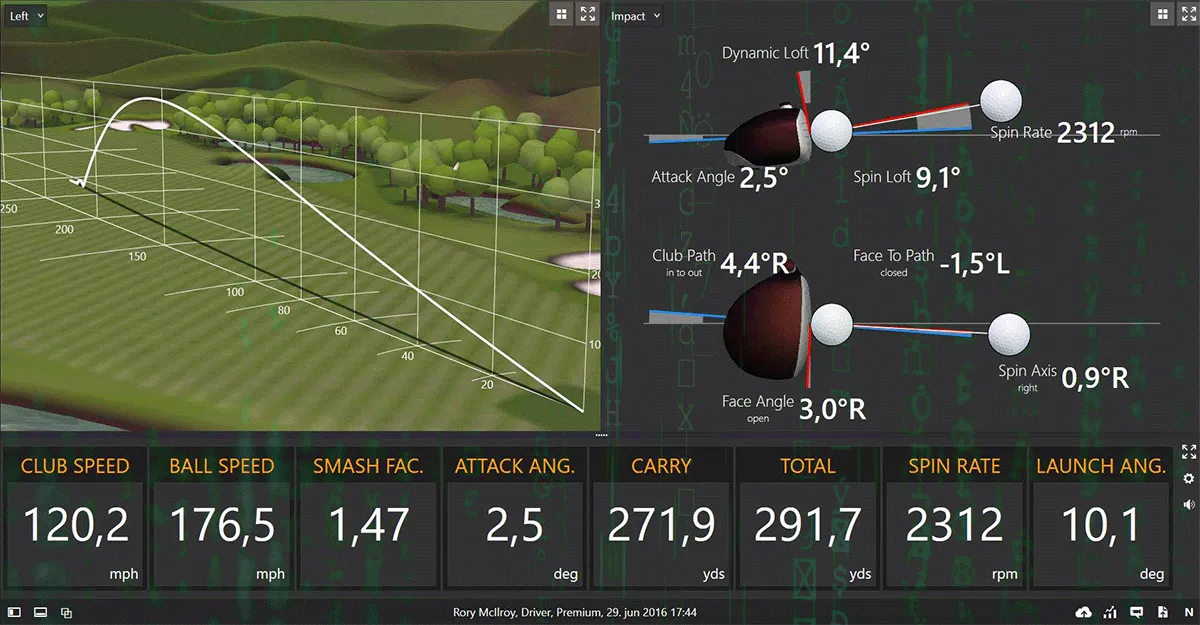
Warning! This one’s for the golf nerds like us! Golf is not a game of perfect, but modern indoor golf simulators have brought players closer than ever to understanding and improving their game. Today’s advanced simulators offer detailed metrics previously reserved only for elite players, allowing you to fine tune the most minute details and help you bring down that handicap. From precise ball-flight details to advanced swing analysis, these commercial golf simulators offer so much more than your garage golf net setup. Here’s a comprehensive breakdown of the valuable data these simulators provide, helping golfers at all skill levels enhance their performance.
1. Ball-Flight Data
- Ball Speed: Speed of the ball immediately after impact (mph or kph)
- Launch Angle: Vertical angle at which the ball takes off (°)
- Launch Direction: Horizontal deviation from target line (°)
- Total Spin Rate: Revolutions per minute (rpm) of overall spin
- Backspin Rate: Component of spin around the horizontal axis (rpm)
- Sidespin Rate: Component of spin around the vertical axis (rpm)
- Spin Axis: Tilt of the spin axis (°), indicating draw/fade tendencies
- Carry Distance: Distance ball travels in the air before landing (yards/meters)
- Total Distance: Carry plus roll-out (yards/meters)
- Roll Distance: Estimated roll after landing (yards/meters)
- Apex Height: Maximum height reached during flight (feet/meters)
- Descent Angle: Angle at which the ball descends back to turf (°)
- Side Angle: Lateral departure angle (°)
2. Club-Delivery Data
- Club Head Speed: Speed of the club head at impact (mph or kph)
- Club Path: The swing’s travel line relative to target (° in-to-out, out-to-in)
- Face Angle: Club face orientation at impact (° open/closed)
- Dynamic Loft: Loft of the club at the moment of impact (°)
- Angle of Attack: Vertical angle of the club’s travel at impact (° up/down)
- Smash Factor: Ball Speed divided by Club Head Speed (efficiency ratio)
- Club Acceleration: Change in club head speed just before impact (g’s)
- Low Point: Distance past the ball where the club bottoms out (inches/cm)
3. Impact & Interaction Metrics
- Face Impact Location: Where on the clubface the ball struck (heel/toe, high/low)
- Energy Transfer Efficiency: Percentage of energy transferred from club to ball
- Sweet-Spot %: Proportion of shots struck within the club’s optimal face zone
- Spin Loft: Difference between dynamic loft and angle of attack (°)
4. Shot Trace & Visualization
- 2D/3D Ball Flight Trace: On-screen representation of flight arc
- Landing Pattern: Plot of where repeated shots land relative to target
- Heat Maps: Aggregated impact or landing zones over multiple swings
5. Course & Simulation Data
- Virtual Course Mapping: GPS-accurate layouts of real world courses
- Pin Placement Adjustment: Move hole location to simulate different pin positions
- Environmental Conditions (some systems): Wind speed/direction, temperature, humidity
6. Lesson-Specific & Advanced Analytics
- Swing Tempo & Rhythm: Backswing to downswing timing ratio
- Transition Speed: Acceleration profile from backswing to downswing
- Release Points: Clubface rotation at various points through impact zone
- Kinematic Sequencing: Hip-shoulder-arm motion order for advanced rigs
How to Leverage Simulator Data
- Club Fitting: Use ball-flight and club-delivery stats (smash factor, spin rates, launch angles) to select optimal shaft flex, loft, and clubhead design.
- Instruction & Swing Improvement: Track angle-of-attack, club-path, and face-angle trends to correct slices, hooks, fat/thin shots, or optimize launch.
- Performance Benchmarking: Compare your carry distance, apex height, and spin axis against pros or past personal sessions to set targets.
- Course Strategy: Simulate how environmental factors and pin positions affect approach shots, helping you practice real-world scenarios.
—
By taking advantage of the rich data provided by modern golf simulators, players can systematically improve their swing, lower their scores, and enjoy the game even when conditions outdoors aren’t ideal (We know how cold it gets in The Windy City). And while many golfers are just looking for a more casual time, indoor golf is still a better alternative to Topgolf. Embracing these insights can make indoor golf training both productive and rewarding, turning every indoor golf lesson into a step toward mastery.
Ready to nerd out on your swing data? Easily filter for lessons through our hundreds of golf facilities. Find the best indoor golf near you right here
